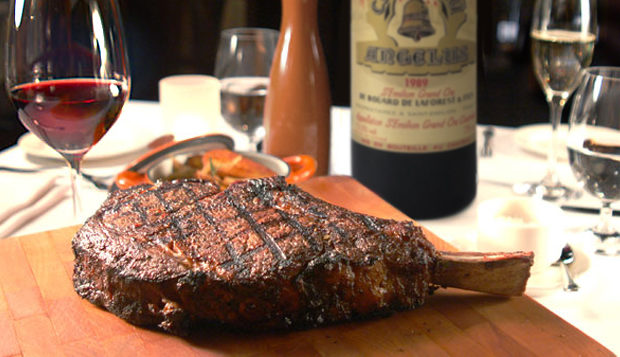INNER 007 -- James Bond is a connoisseur of great food, there is no doubt. From cracked stone crabs with melted butter and pink champagne in Miami, to prawn curry made by an Asian chef (okay, it was Oddjob, but the man could apparently cook), to grilled ray with butter sauce in the Caribbean, to Beef Ragout made by gypsies in Turkey, Bond is a lover of great food and its endless variety.
Few people, though, notice the common link between Bond’s favorite dishes and styles of food: he eats very close to what we would nowadays call a Paleo Diet.
What is the Paleo Diet?
The Paleo Diet, also called the Caveman, Evolutionary, Primal, Ancestral, or Hunter-Gatherer Diet, is an attempt by modern man to emulate the style of eating that our pre-agricultural ancestors enjoyed and thrived upon. Generally, this evokes images of Fred-Flintstone-sized ribs and steaks, and sitting around the campfire without utensils. It also screams "fad diet" and causes many people to dismiss it as just that. 
Nothing could be further from the truth. The idea of the Paleo Diet is more that its adherents do not eat items that our Paleolithic and pre-agricultural ancestors didn’t have available to them. That means they didn’t eat foods made with grains, legumes, or dairy, for the most part. They definitely didn’t eat foods made with industrial seed oils, processed boxed junk, or added sugars.
But cavemen only lived to be 25 to 30 years old!
Yes, they did… on average. But once you adjust that average to remove deaths that were caused by infant mortality (which we have a much better handle on due to modern medicine), accidental deaths (a sprained ankle no longer means you’re going to be eaten by a saber-toothed tiger), infection and disease (again, see modern medicine), you’re looking at a life-span of 75-85 years.
And, more importantly, those folks who did live to an advanced age in those times (and in modern-day hunter-gatherer societies) were much more active and healthy, with little to no indication of the diseases that many consider just a part of getting old – heart disease, cancer, arthritis, diabetes, and other "diseases of civilization."
There were interesting anthropological studies done comparing the remains people from the same area where one group were primarily hunter-gatherers and the others were primarily farmers. The hunter-gatherers were generally larger, more muscular, and showed less sign of disease and ill health than the farmers.
So, what did they eat?
They ate as much meat as they could get. They ate the vegetables they could find. They ate fruits that were in-season. They probably gathered some nuts. And they probably even ate bugs, grubs, etc. as these were a great source of protein and that all-important nutrient, fat.
Whoa… fat?
Yes, fat. Evolutionary biology indicates that the main nutrient for our pre-agricultural ancestors was, in fact, fat. Fat was so prized as a nutrient that it was frequently eaten first when a kill was made while hunting. And fat is actually a much better nutrient source for us than carbohydrate. Paleo nutritionist Nora Gedgaudas likes to compare fat to a slow-burning log on the fire in our diet, as compared to what most people nowadays consider our primary energy source, carbohydrates–which she likens to rocket fuel. It fires up our systems with a massive influx of energy and then goes away just as quickly–requiring us to either keep eating it all day or crash hard.
That’s not to say that our bodies don’t need carbohydrates. They absolutely do–many functions of the liver and brain require glucose, a carbohydrate, to operate. We just don’t need as much of them as we’re getting on a regular basis. Eating some veggies every day will pretty much take care of your body’s carbohydrate needs, and you don’t need all the anti-nutrients that come along with the grains that normally provide our carbohydrate load. And if you need, your body is fully capable of making carbohydrate from amino acids in the bloodstream via a process known as gluconeogenesis.
Anti-nutrients?
Absolutely. Grains and legumes contain a number of substances that were designed to help protect them from predators by making them indigestable, making the consumers sick, and letting seeds pass through their systems. Gluten, for example, is one of these. It’s a known epigenetic trigger for a number of conditions, including Huntington’s Disease, and it’s linked to neurological issues like Autism and Schizophrenia, and possibly ADHD. And possibly more, the research is still out. And of course people with Celiac disease are deathly allergic to it.
Lectins are another anti-nutrient. They cause the breakdown of the intestinal lining, causing problems with leaky gut and intestinal inflammation. There’s a whole new line of research going on now about the dangers of leaky gut and intestinal inflammation and the diseases that can be caused by that. Leaky gut occurs when the single-celled lining of the intestines is inflamed and broken down by bad diet, and the matter that is supposed to be pushed through the intestines to be processed by the masses of bacteria in there begins to leak into the bloodstream. This has been linked to numerous maladies as well, including general inflammation, autoimmune disorders, diabetes, cancer, cardiovascular disease and atherosclerosis, and much more.
Phytates are a third issue with non-Paleo foodstuffs. These are substances that bind with minerals coming into the body and force them to pass through the intestinal tract unabsorbed. In other words, some of your food can cause you to not get the full benefit of your other food.
So it’s a low-carb diet?
Not necessarily. Though it’s definitely lower-carb than the current Standard American Diet (which Paleo folks like to abbreviate to SAD), it’s not necessarily so. Some hunter-gatherer societies did very well and were very healthy on a diet of higher-carbs along with their meat and fats–like Pacific Islanders and Okinawans (some of the longest-lived people on earth). Others did very well with higher fat and extremely low-carb diets, like the Eskimos or Plains Indians. Paleo researcher and author Paul Jaminet recommends a diet of approximately 30% carbohydrate, for example. That’s still much lower than the SAD.
Paleo blogger and The Primal Blueprint author Mark Sisson put together a graph of what he feels the best levels of carbohydrate intake are, depending on your own health goals. He also points out that most modern-day western Europeans and Americans are in the Danger Zone, below:
300 or more grams/day – Danger Zone!
150-300 grams/day – Steady, Insidious Weight Gain
100-150 grams/day – Primal Blueprint Maintenance Range
50-100 grams/day – Primal Sweet Spot for Effortless Weight Loss
0-50 grams/day – Ketosis and Accelerated Fat Burning
Many people who want more carbohydrate in their diets simply eat vegetables like sweet potatoes, jicama, or other tubers. Even plain white rice isn’t all that bad, despite it being a grain – once it’s been hulled and cleaned to remove the anti-nutrients.
But what about all those healthy whole grains?
They’re not as healthy as you think they are. In fact, because they frequently contain the substances that we described above, like gluten, lectins, and phytates, they’re actually less healthy than the more processed stuff. But no grains are really good for you. And there are no nutrients one can get from grains, whole or otherwise, that you can’t also get from vegetables.
But I need them to lower my cholesterol?
 Why? A little known fact is that there is really no clinical evidence for cholesterol or saturated fat being a factor in heart disease. Author, clinician, and blogger Chris Kresser has collected a huge body of research about this. Cholesterol is actually a vital bodily nutrient and substance for cell repair. It also makes up a large portion of the material that bridges the gaps between neurons in the brain. In fact, many children with epilepsy (caused at least partially by misfiring neurons in the brain) have had a remission of all symptoms via a high-cholesterol, ultra-low-carb diet. And it’s also benefited many children with autism and other neurological disorders.
Why? A little known fact is that there is really no clinical evidence for cholesterol or saturated fat being a factor in heart disease. Author, clinician, and blogger Chris Kresser has collected a huge body of research about this. Cholesterol is actually a vital bodily nutrient and substance for cell repair. It also makes up a large portion of the material that bridges the gaps between neurons in the brain. In fact, many children with epilepsy (caused at least partially by misfiring neurons in the brain) have had a remission of all symptoms via a high-cholesterol, ultra-low-carb diet. And it’s also benefited many children with autism and other neurological disorders.
Yes, cholesterol does build up in the arteries, there’s absolutely no doubt about that. But it’s not because of dietary cholesterol, or even the serum cholesterol that we get checked with our bloodwork. It’s because of one thing: inflammation.
What is inflammation? Sounds horrible.
Inflammation goes back to leaky gut and the immune response we get from our bodies trying to fight off all the unprocessed and partially processed food that is leaking into our bloodstreams. Some researchers also think that it’s related to the high levels of insulin constantly floating around in our systems. And it’s definitely a root cause of all those so-called "diseases of civilization," like cardiovascular disease, cancer, diabetes, Alzheimer’s, multiple sclerosis, and many more.
For example: in the case of atherosclerosis, which we mentioned above, inflammation causes the body to send cholesterol (its repair substance) to cover up those inflamed areas–and if the body keeps getting the kind of nutrition that caused it to get inflamed in the first place, it’ll continue to do so until the inflammation stops or the artery is completely blocked, causing a cardiac event.
The Paleo Diet is designed to stop inflammation, basically. And that’s done by eating the foods that humans evolved eating as much as possible. And, even more importantly, by not eating those foods that we didn’t evolve eating.
What else should I know?
Keeping your food "real" is the most important thing. Grass-fed or wild-caught meats, eggs, and fish, organic produce (mostly vegetables, and a little bit of fruit)and some nuts are pretty much all you’ll need. If it comes in a box, don’t eat it. This sounds limited, but there’s actually an amazing amount of variety you’ll discover when you get away from just what comes in a box.
Grass-fed meats are important because they will contain more nutrients than corn- or soy-fed animals. They also will contain a better ratio of Omega-3 to Omega-6 fatty acids. Too much Omega-6 can exacerbate inflammation, while Omega-3 helps to alleviate it. And cattle raised on grass (their natural food) have a much better ratio of those nutrients.
Also, cooking your food in the right oils is very important. Avoid seed-based oils like canola, sunflower, corn, and most vegetable oils (also sources of high Omega-6 fatty acids). Use coconut oil, avocado oil, olive oil (as long as you don’t heat it too high), bacon grease, beef tallow, lard, butter or ghee (which is an Indian clarified butter). Those are healthy fats.
If you can’t afford or get grass-fed meats, then buy the leanest cuts of conventional meats that you can, and use the healthy fats and oils above to give you some fat for energy.
Sounds good. How do I get started?
The best way is to do a 30-day "Paleo Challenge," where you clear your house of any and all foods that contains grains, legumes, soy, and dairy, and then eat only Paleo foods. This will do a couple things:
1. If the bad food isn’t in your house, you won’t eat it while you’re home.
2. It’ll help you to reset your genes to work off of fats as a primary energy source instead of carbs.
Some people try this and it’s a breeze. Others have issues for the first couple weeks while their bodies are adjusting – some diarrhea, hunger, headaches, etc. But this will soon pass as your genes switch over to where they need to be and your body adjusts to its new food input.
A few Paleo experts have put together plans to help you along during this time. Below are some of the best:
Robb Wolf’s 30-Day Transformation
The Primal Blueprint 21-Day Total Body Transformation – by Mark Sisson
The 21-Day Sugar Detox from Balanced Bites – by Diane Sanfilippo
The Whole30 from Whole9life.com – by Dallas and Melissa Hartwig
Once you’ve gone through a 30-Day challenge (some of the sites have 21-day plans, but the general rule is stick is out for 30 days to set your system straight) you’ll find in many cases that you don’t want those old foods any more–they’ll make you feel sick or at least a bit off when you eat them (and you’ll wonder how you must have felt all the time while you were eating them regularly).
And once you get going, there are recipe sites galore now, just do a search for Paleo Recipes and you’ll be inundated with great food. Some favorites are:
NomNomPaleo
Civilized Caveman Cooking Creations
FastPaleo
Everyday Paleo
Balanced Bites
In Part Two, we’ll talk about exercise and other factors in the Paleo lifestyle.













Top 5 Rejected James Bond Theme Songs
Top 5 Rejected James Bond Theme Songs
The "No Time To Die" Review